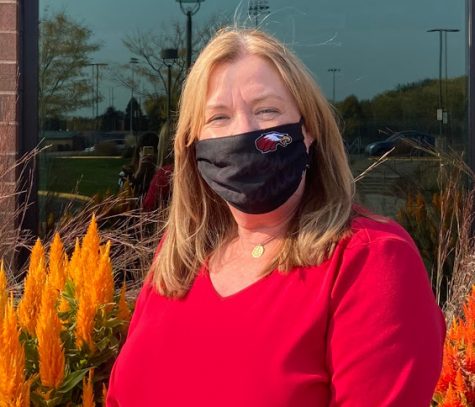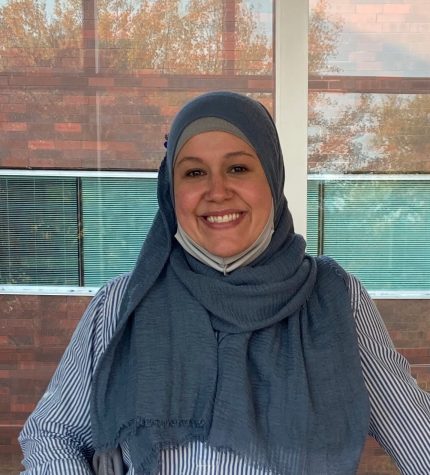Interview with Tony Morimoto: Eden Prairie School Board Candidate 2020
Yes, that’s a dog.
Before Tony Morimoto signed up to run for school board the summer of 2020, he had one important question. “I can sign up with any name?” he asked.
All it took was a “yes” in reply, and that’s how “Brando Morimoto” ended up as a 2020 school board candidate. Brando is Tony Morimoto’s sweet-tempered rescue dog, who loves the couch, snuggles and turkey. Brando greets me with his tail wagging in Tony Morimoto’s office at his shipping company.
Later on, Tony Morimoto had to change the filing to his own name. It turns out he couldn’t sign up with any name because a dog can’t officially run, but Tony Morimoto continues to campaign as one. When a voter looks at his yard signs, his business cards, Instagram, it’s all Brando. The website’s even written under his perspective. There’s barely a human in sight. That’s intentional.
“I don’t want the focus to be on myself,” Tony Morimoto says. Instead, he thinks a candidate’s run should be about the ideas, and Brando acts as a barrier, allowing Morimoto to take himself out of the picture. It becomes a pattern for him to remind me that he’s not an expert, not a parent, not a teacher, and that he embraces it.
Before you go and think it’s crazy, it also might be effective.
According to Morimoto the human, when he goes around campaigning, people are so over politics that they don’t even care to learn his views before agreeing to vote for Brando.
His point is proven, at least in one case, because in the middle of Morimoto laying out his problems with the district’s’ current meal plan, a man walks in the room. It’s Morimoto’s driver for his business, Jay. “Brando for president!” He calls out when he sees the interview (jokingly, I assume, but you never know.) He agrees to sit down for a mini-interview.
“Of course,” he answers when I ask if he would vote for Brando. “I think he’s an amazing dog. I don’t think I have a better option than this,” he says while petting him.
“Do you agree with the views Brando represents?” I question.
“I think, yes.” He pauses, then chuckles before saying, “Elaborate. What are the views that Brando represents?”
Morimoto tells him how he thinks kids shouldn’t be eating pizza three days a week.
“Do you have an alternative?” Jay asks.
“I think there are so many alternatives. There’s rice, there’s beans, there’s other fruits, vegetables other than pizza sauce. Don’t you think?”
“Yes, I agree,” says Jay. But I doubt this conversation really mattered. Jay’s vote was secured before that, simply by Brando’s virtue of not being human. (Or Morimoto being his boss.)
But if Jay, and really any potential voter, did want to look past the puppy eyes of Brando and see what Morimoto the human really believes in before they cast their vote, they would find that the phrase “there are so many alternatives” sums up Morimoto’s motto for more than just pizza.
How students are paired with teachers, what information they want to pursue, and how their school is essentially run are all alternatives Morimoto believes families should have the choice to choose from within the district, and his solution to unlocking that is having the money follow the kid.
He thinks knowledge is cheap, so why give the school board more money when you could be giving it to the students?
Giving all families all alternatives in times of distance learning
Had it not been for Covid-19, Morimoto probably wouldn’t have run, and it’s not just because it gave him a serious case of quarantine boredom. Since the lockdown, he has dubbed distance learning a failure and consequently wanted to advocate for more options, specifically for this time.
“Parents don’t have A or B days. Working-class families need to go to work,” says Morimoto, recalling how much his employees with kids would complain when childcare was a bust. “They don’t have the option to work remotely, and it’s really sad that school has put them in the position where they would have to do that.”
Morimoto points out that a few families have already found replacements outside their district, like pandemic pods for example. Families would take their kids out of the school and set up smaller classes with teachers and a few other kids for daycare and education.
However, says Morimoto, “That doesn’t work for working-class families. Right now school choice is only a choice for the rich.” What he claims is that this choice could be for everyone.
“The idea that money follows the kids would’ve solved a lot of these problems and there’s enough money to do that.” The way Morimoto sees it, students should be able to take the funding they get from the district ($11,000 dollars total from the state and local funding), and with that, set up their own arrangements within the district of how they want to be taught.
In context, Morimoto thinks that a hybrid and distance option simply isn’t enough, and he wants to empower families to make and choose their own.
That could mean a family hiring one teacher to homeschool their kids remotely, perhaps with the family paying for that service with additional cash if they think it’s worth it.
“You could easily set up a program where if the school doesn’t give the option, then parents can have a teacher be paid by the district, 11,000 dollars per kid, to have a pandemic pod,” he declares. “And it’s not that difficult.”
“Because of the people who are super afraid of Covid, there should be an option,” he reasons, but overall he thinks the district owes it to families to provide full-time in-person learning again.
If families know and accept the risk of their kids possibly getting sick, Morimoto doesn’t see why they shouldn’t be able to go to school full time.
“The value is teaching in person,” he says. It’s the service he believes the school ought to provide, and he thinks if teachers are teaching remotely, the current purpose of the district is devalued. If a teacher doesn’t want to do in-person teaching, he would want the district to hire a new one.
All this being said, he concludes, “I don’t care what I believe, I don’t know what’s best for you.” His keyword is “options.” If a family wants to do in-person, they do in-person. If a family is scared of Covid, “we cut you an $11,000 dollar check to homeschool your kid.”
Stop wasting time in eleventh and twelfth grade
As the youngest candidate running, Morimoto remembers going through all the motions of high school: he got good grades in his AP classes, then went off to a good college. It wasn’t until he graduated college when it fully hit him that a lot of what he did was a waste of time. “So you’re in this bubble when you’re in academia because you just listen to what these adults tell you. You think, ‘okay, I need to know things,’ and you just trust them, because they’re adults. Then all of the sudden you become an adult and you’re like, ‘I don’t need to know any of this. I just wasted all this time.’ A lot of what I’m learning post-college is much better than what I’m learning in school.”
“If you critically think about what you’re teaching kids, a lot of it’s a waste of time,” he says. In order to stop wasting time, he wants older students to learn information that can jumpstart their goals for the future. And if they don’t have plans, he says, they need to be given opportunities to get out there and figure out what they want to do.
All of that comes down to ending the normalization of 11th and 12th grade.
Morimoto figures that by then, most kids know if they want to go to college or not. Because of that, he says AP classes in school shouldn’t even be an option when PSEO can guarantee them college credit. “If you’re so smart you’ll be going to go to college, just do all PSEO,” he says, knowing he’s not necessarily able to ban AP classes but wants to discourage them as much as possible. He values PSEO to save time and money: “knock out your two years, and you only have to pay for college for two years.”
“Say you want to be a doctor,” he says. “Why not have an option to only take science and math classes?” According to him, students should have more choices in their curriculum than just electives if they know what career they want to pursue.
As for people who aren’t college-bound, Morimoto says there should be a better option than high school for them too. “They might be smart at something else, right?” he says, going on to explain that by now, students who already have a specific skill or interest should be able to pursue it.
Take a student who’s really good with tools, but not much of anything else, he says. “Why should they be spending two more years at school when they could be making 100 dollars per hour as a plumber, or as an apprentice?”
With his plan, he thinks there could be technical schools set up in the district, or in general, more flexibility for that student to ditch school and start working. “By the time they graduate, they could be a plumber. That’s not an option right now. That should be an option.”
As for people who don’t have a clue of any interests or goals, he would encourage them to pick a path and run with it anyways. “If you can move that up and start failing now, then the sooner you figure out what you want to do,” he predicts. For Morimoto, finding out what you don’t like is a more valuable use of time than nothing, and it’s cheaper in your teens.
He doesn’t want to waste students’ time by making them learn information they won’t use. If you want to be an English major, “why waste time and spend energy taking math for two more years when that energy can be focused somewhere else?” he asks. “It’s not that difficult to curate a plan for individuals.”
Pair students and teachers up because people learn differently
“You don’t need to spend eight hours a day teaching someone if you can spend 40 minutes teaching them effectively,” he says, because while how one teacher teaches might work wonders for one student, there’s always another student who could be doing much better with a different type of instructor. “That’s why pairing teachers and students together is so important. Because people learn differently.”
“A lot of the people running, they’re like, ‘I know what’s best for you, and everyone’s the same,’ and that’s not how I think.” In his ideal plan for the district, students would get the option to choose which teacher best suits them. “Student voice, teacher choice,” he likes to say.
“Everyone’s completely different. Everyone has their own special needs. And it’s crazy to try to teach everybody the same thing. Especially when that’s not how their brain works.”
Before he wraps up his argument, however, he makes yet another disclaimer: “I don’t know anything about kids. I don’t have kids. But I trust that the parent will care more about their kid and seek out the best person to teach their kids better than I could ever.”
“And that’s why I take myself out of there,” he adds. “That’s why Brando’s running. Because I don’t want to run. Because I don’t know anything. And I’m happy to tell people that. That’s why I want to give the option to teachers, parents and students. Because I trust that they know what’s best for them.”
Inflexibility causes failure
“Take ten random kids. I guarantee you, we can get more than six proficient in math,” says Morimoto when asked about the achievement gap. As usual, he thinks the district is failing.
“Twelve years, and you only get six out of ten that can pass a math test? That’s crazy. It doesn’t make any sense.” He doesn’t think the issue relates to race or class. Instead, he says, “there has to be something wrong with the system for it to do that. It’s something wrong with how things are done.”
If statistics really were to improve, the biggest obstacle in their way is inflexibility. “That’s what traditional schools have– it’s inflexibility,” he says, and that’s what he wants to get rid of.
If they’re behind, “a better focus for those kids is the foundations, and we can spend more time with that,” he says. But the inflexibility makes it harder.
For one change, he starts, “focus on what’s important. And guess what? there’s a ton of things that aren’t important.”
“Well, he’s failing at math, he’s failing at reading. Okay, well why are we spending so much time in art?” he wonders. He thinks letting that kid spend four hours on math and reading instead with no other subjects or homework would be a better use of time.
“Eden Prairie brags, ‘we only have so many kids per class,’” but Morimoto doesn’t think the praise is well earned. “The teachers are still spending time to teach for the masses,” he argues. “It’s probably better for those kids who aren’t learning as effectively to only have four other kids in class.”
This is the hyperspecialization he believes could make an impact and could happen under a system where the funding follows the student.
“Saying all that,” reminds Morimoto, “I’m not a teacher, I don’t know a lot of stuff. That’s why I want to empower people to do what they want to do, and if that’s what’s better, then that’s what they should do.”
Can he do it?
Fundamentally altering the way the district is run sounds like a daunting task, but Morimoto already has step one laid out: “You first fire the superintendent and all the administrators. And then we hire somebody who wants to do that. Because that’s all we can do, really.”
Actually, the first step is to win. And all things considered, he likes his odds. “Can I win? Absolutely. Got a fifty-fifty shot.”
This is the thought process of the typical voter, he says: “‘What names do I like?’ They get three choices. ‘Morimoto? Okay, let me look at my phone, quick look at the web page– dog? I’m in.’ That’s what it’s going to be down to.”
Since he still needs a majority vote from the other members to carry out any plans, even if he gets elected, to what extent his goals become reality is unclear. He’s hopeful though. He thinks he’ll be able to convince other board members, “– maybe not the current ones, because I call them all incompetent– but at least some,” he says, to go along with him and see how far he can go.
“I don’t know– everything is so broken. And if we keep doing the same thing we’ll keep getting the broken system.”
It’s time for a change, he says. “We’ve been doing the same thing for thirty years. You gotta do something different, and it’s the way the system’s’ set up. It’s nothing else. It’s the system.”
Contrary to what he said before, he does care about the kids
“I don’t care about your kids.” That was Morimoto’s closing statement in one of his first publicized forums.
Looking back on it, he reflects, “that’s not what I should’ve said. I do.”
“I feel like I’m the only person advocating for the students,” he says, comparing himself to other candidates. “I only want what’s best for the students. I don’t care about the school. The school is just a building.”
“I want what’s best for the students. But I don’t know what’s best for the students,” he adds.
If a student wants to keep their same education under the hands of the superintendent, that’s fine by him. Whatever he thinks isn’t for everyone. In the end, “only the students know what’s best for each individual. That’s why they should have a choice.”
Get more information about the candidate:
Watch his answers on the school board candidate forum. “Do yourself a favor if you want some fun,” says Morimoto. “I put pizzaz in there:” https://eden-prairie.granicus.com/player/clip/1518?view_id=3&redirect=true
Read his written questionnaire with the Eden Prairie Local News: https://www.eplocalnews.org/2020/09/26/eden-prairie-school-board-election-2020-candidate-questionnaire-tony-morimoto/
Visit the website to see cute pictures of Brando: https://www.cityofep.com/





